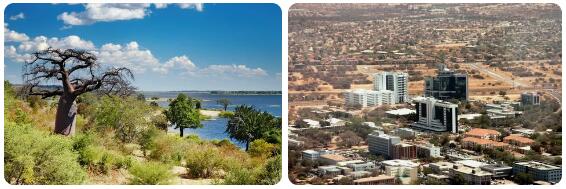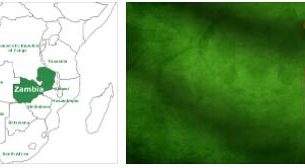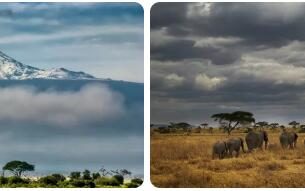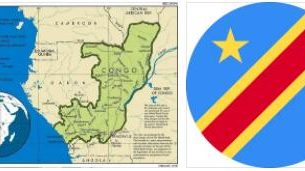Botswana – One of the most stable countries in Africa
A large deposit of diamonds has transformed the country from one of the poorest countries in the world to one of the richest countries in Africa in just 37 years.
A good third of Botswana’s population is employed in mining. The diamond export accounts for almost 80 percent of the total export and around 75% of the state budget. Production is monopolized by the state-owned Debswana company, and all revenues flow directly into the national budget.
Unfortunately, the country has one of the highest AIDS rates in the world; 40 percent of all adults are infected. The national emergency had to be declared because the epidemic threatens the continued existence of the economy.
The HIV-positive patients are given free drugs that are anti-retroviral as part of the state program “Masa” (Eng. New Sunrise). This measure is unique in the whole world.
But Botswana is still one of the most stable and safest countries in Africa for tourists. A visit is therefore worthwhile, but also because of the wonderful nature and the numerous animals.
| Name of the country | Republic of Botswana, Republic of Botswana |
| Form of government | Presidential Republic |
| Geographical location | South Africa |
| National anthem | Fatshe leno la rona (Blessed be this noble land) |
| National holiday | Sep 30 and Oct 1 (independence: 1966) |
| Population | about 2.3 million (Credit: Countryaah: Botswana Population) |
| Ethnicities | approx. 60% Tswana, 12.5% Shona, furthermore San (Bushmen) Khoi Khoi (“Hottentots”), Ndebele and 4% members of other African tribes.There are also around 110,000 foreigners living here (20,000 Indians, 15,000 Chinese and around 4,000 Europeans). |
| Religions | about 70% Christians, the rest are followers of traditional natural religions |
| Languages | English (official language) and Bantu languages |
| Capital | Gaborone with around 240,000 residents |
| Surface | 581,730 km² |
| Highest mountain | Tsolido Hills with a height of 1,489 m |
| Longest river | Limpopo with a length of 1,600 km |
| Largest lake | Makgadikgadi with an area of km² |
| International license plate | RB |
| National currency | 1 pula = 100 Thebe |
| Time difference to CET | + 1 h |
| International phone code | 00267 |
| Mains voltage, frequency | 220/250 volts and 50 hertz |
| Internet TLD (Top Level Domain) | .bw |
Botswana: history
Until around the year 1300
The first demonstrable settlement of the Kalahari took place around 100,000 years ago. The direct descendants of these Stone Age settlers are probably the Bushmen (San) and the Khoikhoi (“Hottentots”). Around the year 250, the immigration of Bantu peoples into what is now Botswana, who already mastered methods of iron processing, began. The kingdom of Toutswe existed between 650 and 1300 and its economy was based on livestock farming.
From the year 1000 to the 19th century
According to Abbreviationfinder website, in the 14th century the region was colonized by the Batswana people, who established various small kingdoms. Around 1800 the entire eastern part of what is now Botswana was populated by Batswanas. The Zulu Wars in the 19th century resulted in the immigration of Bakolo and Ndebele tribes to the south of the country, which also led to military clashes with the Batswana. In 1845 David Livingstone founded the Kolobeng Mission in Botswana. In the 19th century, Boers (white settlers) who had fled South Africa from the British began to conquer the country. They taxed the Tswana tribes and enslaved parts of the population. From 1876 onwards, the Botswana tribes were granted British support under “protection treaties” at their request. In 1885 what is now Botswana was declared a British protectorate. From the beginning of the 20th century, the British had the local chiefs collect taxes, the so-called “Hut Tax”, from the population.
20th century until today
The Tswana kings Khama III, Bathoen I and Sebele I managed to enforce compliance with the protection treaties in 1895 and thus prevent the planned administration and exploitation of the land by the British South Africa Company. Despite this, the Protectorate of Botswana was subsequently administered from South Africa. From 1910 both countries formed a customs union. In 1956 Seretse Khama, who had been deported to England because of his marriage to a British woman, renounced his royal dignity. After his return he played a key role in founding the first independence movements against the British. In 1962 he founded the “Bechuanaland Democratic Party” (BDP).
In 1965 the seat of government was moved to Gaborone in Botswana. On September 30, 1966, the country gained independence with membership of the British Commonwealth. Seretse Khama became the first president. The discovery of the first large diamond deposits at Orapa in 1967 led to a sharp improvement in Botswana’s economic situation.
In 1974 Botswana formed together with Angola, Mozambique, Zambia and Tanzania the group of “front-line states” to support the national liberation movements in Namibia and what was then southern Rhodesia. In 1977, after repeated invasion of Rhodesian troops, the establishment of a Botswana army began.
In 1979, together with Lesotho, Malawi, Zambia, Zimbabwe and Swaziland, the front-line states founded the South African Development Conference (SADCC) based in Gaborone. After the end of the apartheid regime, South Africa also joined this organization in 1992, which was renamed the South African Development Community (SADC).
In 1985 the government started a resettlement campaign of the San (indigenous people) still living in the Kalahari desert into camps, thereby destroying the traditional way of life of this people. The reasons for this were the increasing hunting tourism in the region and the planned expansion of the diamond restricted areas.
In 1992 the country was hit by the most devastating drought of the century, which destroyed over half of the livestock.
In 2000 the eleven member states of the SADC (Southern African Development Community) signed an agreement on the common formation of a customs union.



